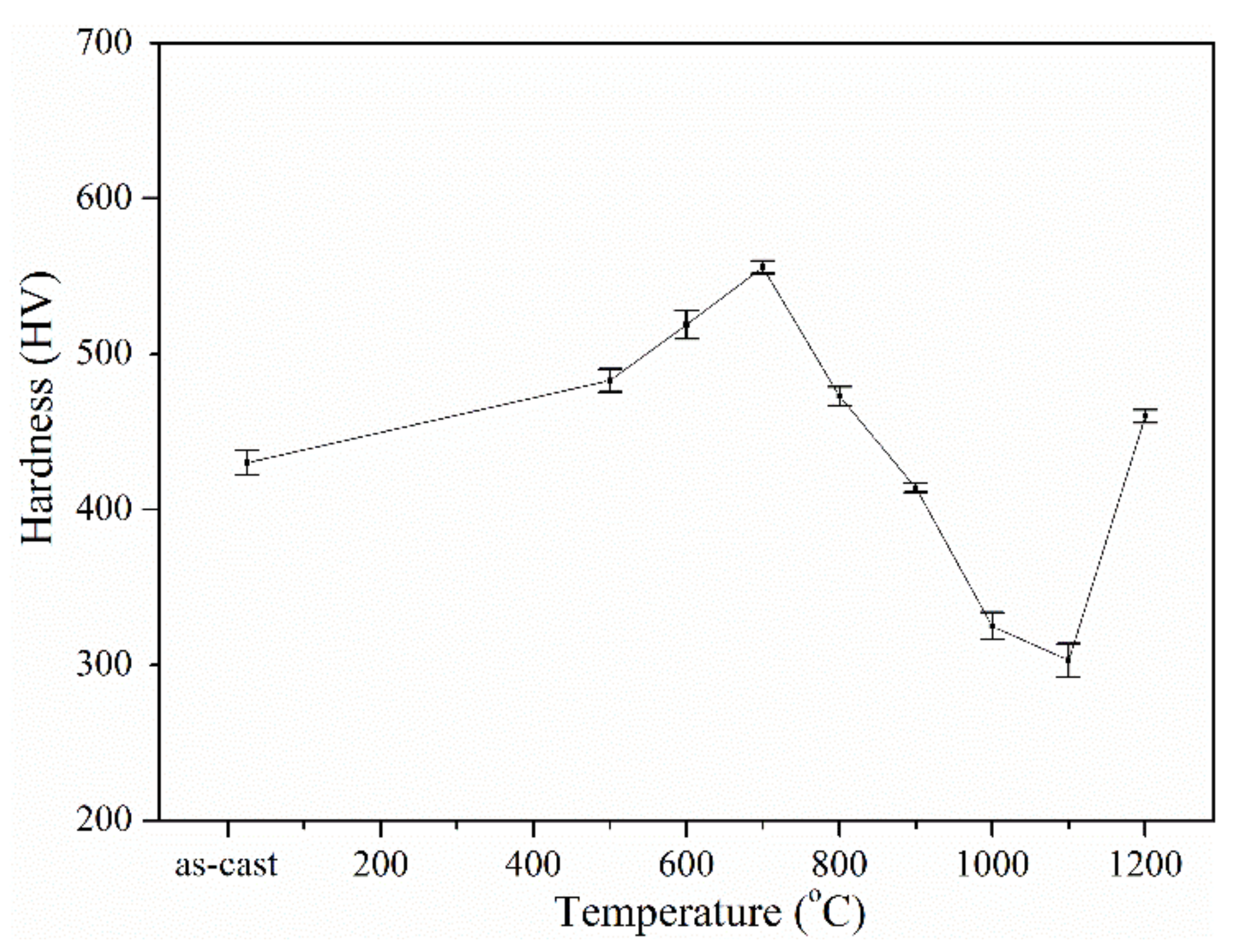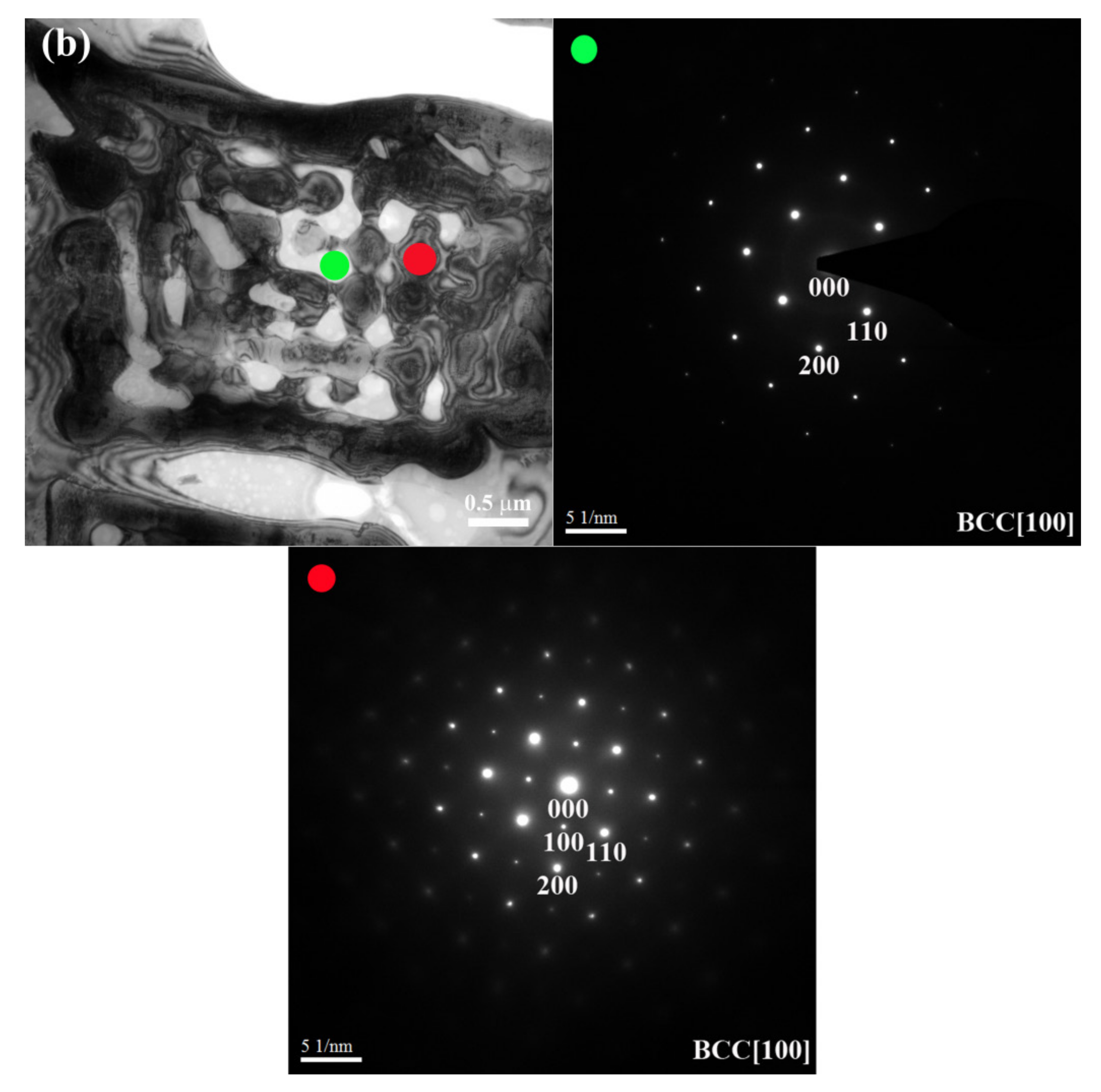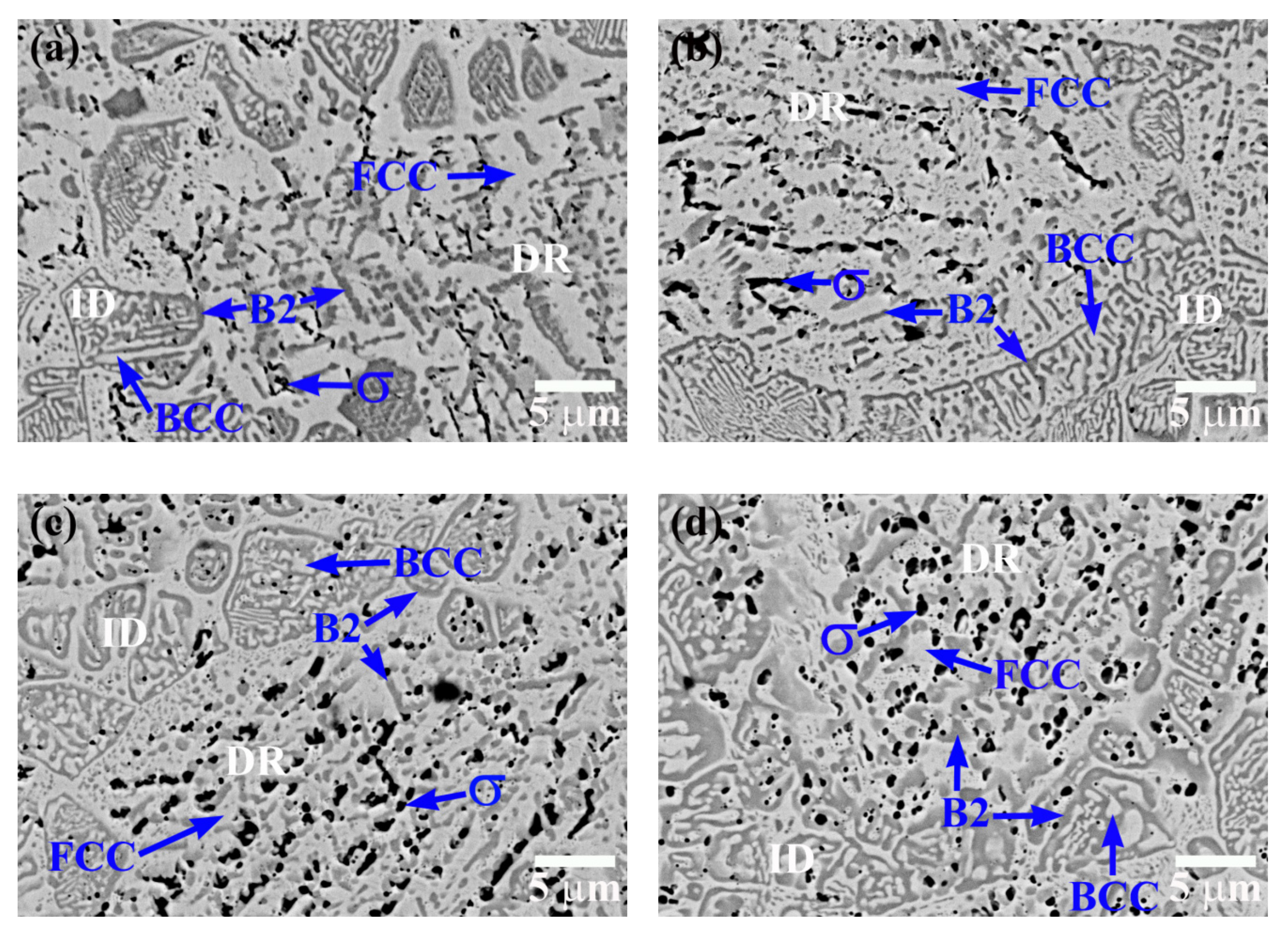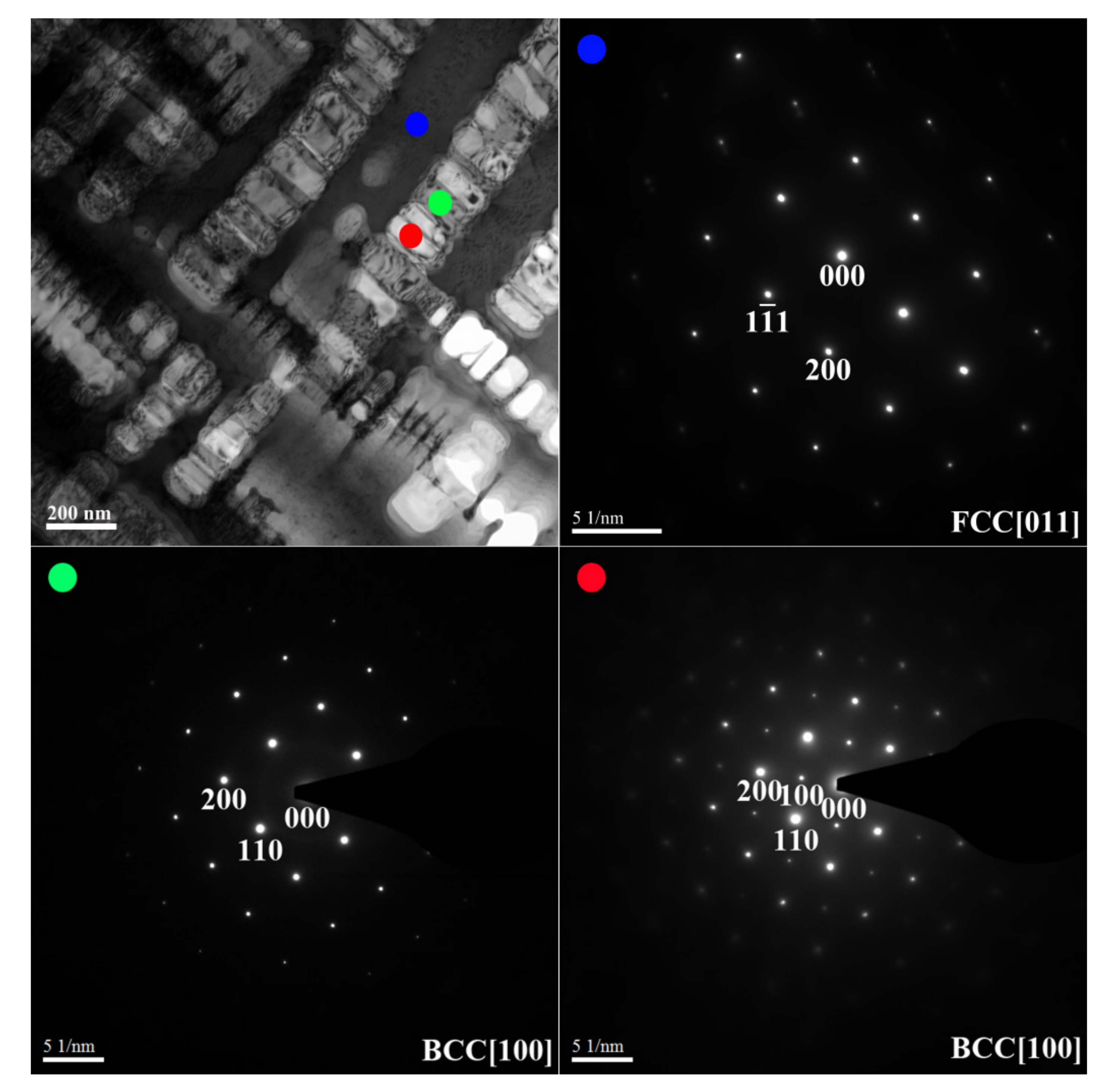Age Heat Treatment of Al0.5CoCrFe1.5NiTi0.5 High-Entropy Alloy
Abstract
:1. Introduction
2. Materials and Methods
3. Results and Discussion
4. Conclusions
Author Contributions
Funding
Institutional Review Board Statement
Informed Consent Statement
Data Availability Statement
Conflicts of Interest
References
- Yeh, J.W.; Chen, S.K.; Gan, J.Y.; Chin, T.S.; Shun, T.T.; Tsau, C.H.; Chang, S.Y. Nanostructured high-entropy alloys with multiple principal elements novel alloy design concepts and outcomes. Adv. Eng. Mater. 2004, 6, 299–303. [Google Scholar] [CrossRef]
- Murty, B.S.; Yeh, J.W.; Ranganathan, S. High-Entropy Alloys, 1st ed.; Butterworth-Heinemann: London, UK, 2014; pp. 18–23. [Google Scholar]
- Gao, M.C.; Yeh, J.W.; Liaw, P.K.; Zhang, Y. High-Entropy Alloys: Fundamentals and Applications, 1st ed.; Springer: Cham, Switzerland, 2016; pp. 53–56. [Google Scholar]
- Yeh, J.W. Recent progress in high-entropy alloys. Ann. Chim. Sci. Mater. 2006, 31, 633–648. [Google Scholar] [CrossRef]
- Yeh, J.W. Alloy design strategies and future trends in high-entropy alloys. J. Met. 2013, 65, 1759–1771. [Google Scholar] [CrossRef]
- Biswas, K.; Yeh, J.-W.; Bhattacharjee, P.P.; DeHosson, J.T.M. High entropy alloys: Key issues under passionate debate. Scr. Mater. 2020, 188, 54–58. [Google Scholar] [CrossRef]
- Beke, D.L.; Erdélyi, G. On the diffusion in high-entropy alloys. Mater. Lett. 2016, 164, 111–113. [Google Scholar] [CrossRef]
- Divinski, S.V.; Pokoev, A.; Esakkiraja, N.; Paul, A. A Mystery of ’Sluggish Diffusion’ in High-Entropy Alloys: The Truth or a Myth? Diffus. Found. 2018, 107, 69–104. [Google Scholar] [CrossRef] [Green Version]
- Ling, C.M.; Tsai, H.L.; Bor, H.Y. Effect of aging treatment on microstructure and properties of high-entropy Cu0.5CoCrFeNi alloy. Intermetallics 2010, 18, 1244–1250. [Google Scholar]
- Ling, C.M.; Tsai, H.L. Effect of annealing treatment on microstructure and properties of high-entropy FeCoNiCrCu0.5 alloy. Mater. Chem. Phys. 2011, 128, 50–56. [Google Scholar]
- Zhang, K.; Fu, Z. Effects of annealing treatment on phase composition and microstructure of CoCrFeNiTiAlx high-entropy alloys. Intermetallics 2012, 22, 24–32. [Google Scholar] [CrossRef]
- Zhang, K.; Fu, Z. Effects of annealing treatment on properties of CoCrFeNiTiAlx multi-component alloys. Intermetallics 2012, 28, 34–39. [Google Scholar] [CrossRef]
- Guo, L.; Wu, W.; Ni, S.; Wang, Z.; Song, M. Effects of annealing on the microstructural evolution and phase transition in an AlCrCuFeNi2 high-entropy alloy. Micron 2017, 101, 69–77. [Google Scholar] [CrossRef] [PubMed]
- Munitz, A.; Meshi, L.; Kaufman, M.J. Heat treatments’ effects on the microstructure and mechanical properties of an equiatomic Al-Cr-Fe-Mn-Ni high entropy alloy. Mater. Sci. Eng. A 2017, 689, 384–394. [Google Scholar] [CrossRef] [Green Version]
- Stepanov, N.D.; Yurchenko, N.Y.; Panina, E.S.; Tikhonovsky, M.A.; Zherebtsov, S.V. Precipitation-strengthened refractory Al0.5CrNbTi2V0.5 high entropy alloy. Mater. Lett. 2017, 188, 162–164. [Google Scholar] [CrossRef]
- Park, J.M.; Moon, J.; Bae, J.W.; Jung, J.; Lee, S.; Kim, H.S. Effect of annealing heat treatment on microstructural evolution and tensile behavior of Al0.5CoCrFeMnNi high-entropy alloy. Mater. Sci. Eng. A 2018, 728, 251–258. [Google Scholar] [CrossRef]
- Munitz, A.; Salhov, S.; Guttmann, G.; Derimow, N.; Nahmany, M. Heat treatment influence on the microstructure and mechanical properties of AlCrFeNiTi0.5 high entropy alloys. Mater. Sci. Eng. A 2019, 742, 1–14. [Google Scholar] [CrossRef]
- Wen, L.H.; Kou, H.C.; Li, J.S.; Chang, H.; Xue, X.Y.; Zhou, L. Effect of aging temperature on microstructure and properties of AlCoCrCuFeNi high-entropy alloy. Intermetallics 2009, 17, 266–269. [Google Scholar] [CrossRef]
- Zhang, K.B.; Fu, Z.Y.; Zhang, J.Y.; Shi, J.; Wang, W.M.; Wang, H.; Wang, Y.C.; Zhang, Q.J. Annealing on the structure and properties evolution of the CoCrFeNiCuAl high-entropy alloy. J. Alloys Compd. 2010, 502, 295–299. [Google Scholar] [CrossRef]
- Tsao, L.C.; Chen, C.S.; Chu, C.P. Age hardening reaction of the Al0.3CrFe1.5MnNi0.5 high entropy alloy. Mater. Des. 2012, 36, 854–858. [Google Scholar] [CrossRef]
- Tsai, M.H.; Yuan, H.; Cheng, G.; Xu, W.; Jian, W.W.; Chuang, M.H.; Juan, C.C.; Yeh, A.C.; Lin, S.J.; Zhu, Y. Significant hardening due to formation of a sigma phase matrix in a high entropy alloy. Intermetallics 2013, 33, 81–86. [Google Scholar] [CrossRef]
- Ren, B.; Liu, Z.X.; Wang, M.X.; Shi, L. Aging behavior of a CuCr2Fe2niMn high-entropy alloy. Mater. Des. 2012, 33, 121–126. [Google Scholar] [CrossRef]
- Lee, C.F.; Shun, T.T. Age hardening of the Al0.5CoCrNiTi0.5 high-entropy alloy. Metall. Mater. Trans. A 2014, 45, 191–195. [Google Scholar] [CrossRef]
- Mohanty, S.; Gurao, N.P.; Padaikathan, P.; Biswas, K. Ageing behaviour of equiatomic consolidated Al20Co20Cu20Ni20Zn20 high entropy alloy. Mater. Charact. 2017, 129, 127–134. [Google Scholar] [CrossRef]
- Stepanov, N.D.; Yurchenko, N.Y.; Zherebtsov, S.V.; Tikhonovsky, M.A.; Salishchev, G.A. Aging behavior of the HfNbTaTiZr high entropy alloy. Mater. Lett. 2018, 211, 87–90. [Google Scholar] [CrossRef]
- Ming, K.; Bi, X.; Wang, J. Precipitation strengthening of ductile Cr15Fe20Co35Ni20Mo10 alloys. Scr. Mater. 2017, 137, 88–93. [Google Scholar] [CrossRef]
- Lee, C.F.; Shun, T.T. Effect of Fe content on microstructure and mechanical properties of Al0.5CoCrFexNiTi0.5 high-entropy alloy. Mater. Charact. 2016, 114, 179–184. [Google Scholar] [CrossRef]
- Guo, S.; Ng, C.; Liu, J.; Liu, C.T. Effect of valence electron concentration on stability of fcc or bcc phase in high entropy alloys. J. Appl. Phys. 2011, 109, 103505. [Google Scholar] [CrossRef] [Green Version]
- Tsai, M.H.; Tsai, K.Y.; Tsai, C.W.; Lee, C.; Juan, C.C.; Yeh, J.W. Criterion for Sigma Phase Formation in Cr- and V-Containing High-Entropy Alloys. Mater. Res. Lett. 2013, 1, 207–212. [Google Scholar] [CrossRef] [Green Version]
- Singh, S.; Wanderka, N.; Murty, B.S.; Glatzel, U.; Banhart, J. Decomposition in multicomponent AlCoCrCuFeNi high-entropy alloy. Acta Mater. 2011, 59, 182–190. [Google Scholar] [CrossRef]
- Wang, W.R.; Wang, W.L.; Wang, S.C.; Tsai, Y.C.; Lai, C.H.; Yeh, J.W. Effects of Aladdition on the microstructure and mechanical property of AlxCoCrFeNi highentropy alloys. Intermetallics 2012, 26, 44–51. [Google Scholar] [CrossRef]
- Gwalani, B.; Gorsse, S.; Choudhuri, D.; Styles, M.; Zheng, Y.; Mishra, R.S.; Banerjee, R. Modifying transformation pathways in high entropy alloys or complex concentrated alloys via thermo-mechanical processing. Acta Mater. 2018, 153, 169–185. [Google Scholar] [CrossRef]
- Gwalani, B.; Choudhuri, D.; Liu, K.; Lloyd, J.T.; Mishra, R.S.; Banerjee, R. Interplay between single phase solid solution strengthening and multi-phase strengthening in the same high entropy alloy. Mater. Sci. Eng. A 2020, 771, 138620. [Google Scholar] [CrossRef]
- Tsai, C.W.; Chena, Y.L.; Tsai, M.H.; Yeh, J.W.; Shun, T.T.; Chen, S.K. Deformation and annealing behaviors of high-entropy alloy Al0.5CoCrCuFeNi. J. Alloys Compd. 2009, 486, 427–435. [Google Scholar] [CrossRef]
- Tsai, M.H.; Yuan, H.; Cheng, G.; Xu, W.; Tsai, K.Y.; Tsai, C.W.; Jian, W.W.; Juan, C.C.; Shen, W.J.; Chuang, M.H.; et al. Morphology, structure and composition of precipitates in Al0.3CoCrCu0.5FeNi high-entropy alloy. Intermetallics 2013, 32, 329–336. [Google Scholar] [CrossRef]
- Asabrea, A.; Kostka, A.; Stryzhyboroda, O.; Pfetzing-Micklich, J.; Hecht, U.; Laplanche, G. Effect of Al, Ti and C additions on Widmansätten microstructures and mechanical properties of cast Al0.6CoCrFeNi compositionally complex alloys. Mater. Des. 2019, 184, 108201. [Google Scholar] [CrossRef]
- Moravcik, I.; Gamanov, S.; Moravcikova-Gouvea, L.; Kovacova, Z.; Kitzmantel, M.; Neubauer, E.; Dlouhy, I. Influence of Ti on the Tensile Properties of the High-Strength Powder Metallurgy High Entropy Alloys. Materials 2020, 13, 578. [Google Scholar] [CrossRef] [Green Version]








| Phases | Al | Co | Cr | Fe | Ni | Ti |
|---|---|---|---|---|---|---|
| FCC | 3.1 | 18.3 | 19.0 | 31.8 | 19.3 | 8.5 |
| BCC | 3.5 | 16.5 | 30.3 | 35.3 | 10.1 | 4.3 |
| B2 | 19.7 | 19.0 | 5.4 | 10.9 | 26.5 | 18.5 |
| Phases | Al | Co | Cr | Fe | Ni | Ti |
|---|---|---|---|---|---|---|
| FCC | 3.6 | 19.9 | 23.1 | 30.1 | 17.3 | 6.0 |
| BCC | 4.3 | 14.1 | 33.4 | 37.2 | 8.5 | 2.5 |
| B2 | 22.9 | 18.7 | 4.2 | 10.2 | 24.4 | 19.6 |
| Phases | Al | Co | Cr | Fe | Ni | Ti |
|---|---|---|---|---|---|---|
| FCC | 2.8 | 18.7 | 18.1 | 31.2 | 20.0 | 9.2 |
| BCC | 3.3 | 15.3 | 31.6 | 36.0 | 10.6 | 3.2 |
| σ | 1.4 | 15.8 | 37.9 | 31.5 | 8.4 | 5.0 |
| B2 | 22.0 | 18.7 | 4.9 | 9.2 | 25.8 | 19.4 |
| Phases | Al | Co | Cr | Fe | Ni | Ti |
|---|---|---|---|---|---|---|
| FCC | 2.0 | 17.8 | 24.4 | 39.3 | 13.9 | 2.6 |
| BCC | 15.5 | 17.6 | 15.2 | 22.7 | 18.3 | 10.7 |
| B2 | 22.3 | 19.1 | 4.9 | 11.4 | 24.0 | 18.3 |
Publisher’s Note: MDPI stays neutral with regard to jurisdictional claims in published maps and institutional affiliations. |
© 2021 by the authors. Licensee MDPI, Basel, Switzerland. This article is an open access article distributed under the terms and conditions of the Creative Commons Attribution (CC BY) license (http://creativecommons.org/licenses/by/4.0/).
Share and Cite
Lee, C.-F.; Shun, T.-T. Age Heat Treatment of Al0.5CoCrFe1.5NiTi0.5 High-Entropy Alloy. Metals 2021, 11, 91. https://doi.org/10.3390/met11010091
Lee C-F, Shun T-T. Age Heat Treatment of Al0.5CoCrFe1.5NiTi0.5 High-Entropy Alloy. Metals. 2021; 11(1):91. https://doi.org/10.3390/met11010091
Chicago/Turabian StyleLee, Che-Fu, and Tao-Tsung Shun. 2021. "Age Heat Treatment of Al0.5CoCrFe1.5NiTi0.5 High-Entropy Alloy" Metals 11, no. 1: 91. https://doi.org/10.3390/met11010091




